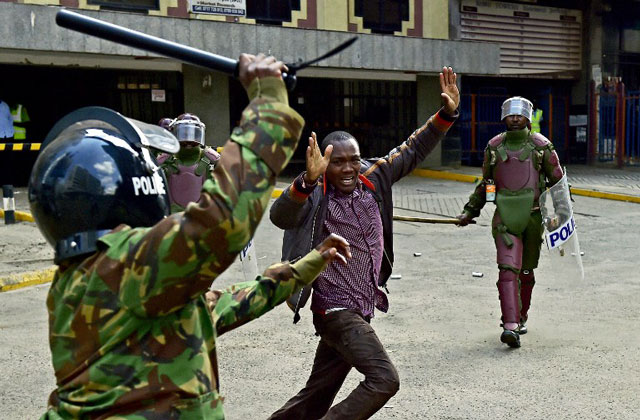
Nairobi, Kenya | AFP | Live bullets, raids on houses and clouds of tear gas: for human rights defenders, the crackdown on Kenya’s opposition protest movement is yet another example of police impunity.
Frequently accused of extrajudicial executions, Kenya’s security forces have defended their actions, saying their men had at times been cornered by demonstrators, denying charges put forward by rights groups.
But the number of deaths and injuries which have occurred during Kenya’s political crisis speaks for itself, says Otsieno Namwaya, co-author of a report on police brutality which was jointly published by Human Rights Watch (HRW) and Amnesty International two weeks ago.
At least 49 people have died since the first presidential election on August 8, which was later overturned, in Kenya’s worst political turmoil in a decade.
The vast majority have been shot dead by police, rights groups say.
– ‘Excessive force’ –
“In certain cases, policemen have shot live bullets at fleeing protesters,” said Namwaya, pointing to an “excessive use of force” in opposition strongholds in the west of the country and in the slums of Nairobi, the capital.
It is a well-trodden path: demonstrators take to the streets, building barricades and throwing stones, and at times looting shops, while riot police respond by firing tear gas and warning shots and sometimes firing directly at them.
For the most part, those who died were demonstrators, but there were also others like a nine-year-old girl who was killed by a stray bullet as she stood on a balcony in a Nairobi slum.
In some cases during demonstrations, a group of uniformed men can be seen beating a single protester even as he lays on the ground.
– Baby killed –
Thursday’s presidential re-run was ordered by Kenya’s Supreme Court after it overturned the August victory of President Uhuru Kenyatta over “irregularities”.
But two weeks beforehand, opposition leader Raila Odinga pulled out, calling a boycott on the grounds the vote would not be free and fair.
In four counties in the west, the re-run never got off the ground, with Odinga supporters preventing hundreds of polling stations from opening, forcing election officials to postpone the vote — first to Saturday, then once again to an as-yet-unknown date
– ‘Full accountability’ –
On Friday, international observers, among them those from the EU and the African Union, called for calm, urging Kenyans “to refrain from unlawful acts and respect the rights of fellow citizens”.
But they also said it was “imperative” that security forces avoid the excessive use of force, and demanding “full accountability of the security agencies for all actions taken that result in injury and loss of life”.
The crisis is Kenya’s worst since 2007 when another divisive vote sparked months of politically-driven ethnic violence that left 1,100 people dead.
“Impunity in police forces is a problem,” admitted Namwaya. “Policemen know they can shoot and get away with it.”
In recent months, the police appear to be going further than simply confronting protesters in the streets, taking a heavy-handed approach in the slums as well as beating demonstrators with batons, sometimes with deadly force, rights groups say.
Speaking to AFP on Thursday at a hospital in the western city of Kisumu, five people said they had been beaten by police in their homes.
Duncan Baraza, who had a broken arm, said police forced their way into his home in the Nyalenda slum. “They beat me up without even saying why,” he said.
Similar accounts emerged in August when police forced their way into a house in a Kisumu slum and attacked a couple with batons, critically injuring their six-month-old baby girl who later died.
The father said police had fired tear gas into the house before battering down the door and attacking them as the mother was holding the baby in her arms.
– Local police sidelined? –
On Thursday, Kisumu governor Anyang Nyongo, who is close to Odinga, lashed out at the violence, saying the police were acting like a “militia”.
“I don’t understand why police should use live bullets to disperse people. They should use water cannon or tear gas. Not live bullets,” he said.
For HRW’s Namwaya, the fact that in some areas the local police had been sidelined in favour of officers from the GSU, a paramilitary unit within the national police, had some bearing on the violence.
“The GSU acts as if it had orders, and that those orders were to use violence,” he said.
“When the local police are in charge of operations, the number of cases of violence is less important.”
In the coastal city of Mombasa, an AFP photographer saw a local police chief accompanied by a priest trying to speak with angry demonstrators in a move which helped to calm the situation, and in that case, the GSU was not called to intervene.
 The Independent Uganda: You get the Truth we Pay the Price
The Independent Uganda: You get the Truth we Pay the Price



